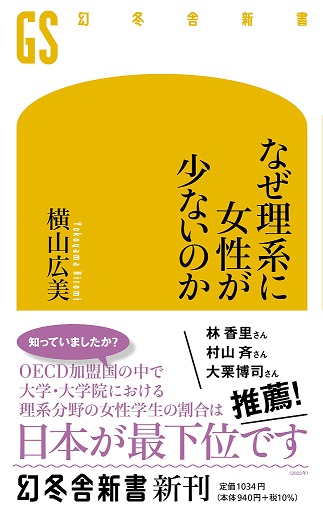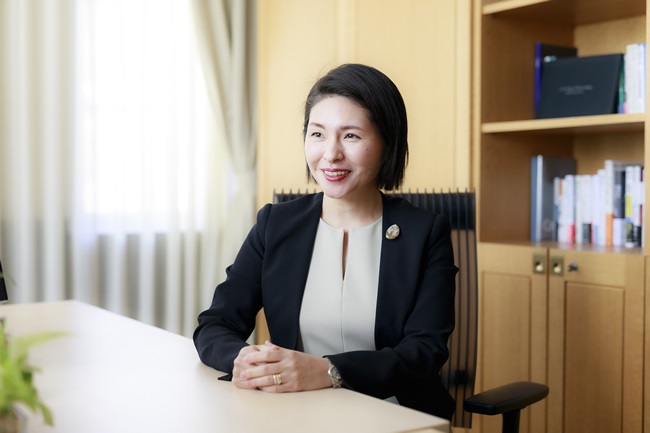
本研究グループについて/ About the Group
理系の女子割合はなぜ低いのでしょうか。中でも物理系を基礎とする分野に注目をしています。第1フェーズではJST-RISTEX「科学技術イノベーション政策のための科学」横山プロジェクト(2017.10-2021.3)にて、この要因に社会風土に注目をして研究を行いました。第2フェーズは、2023年4月に科研費で再スタートし、さらにメンバーを拡充して共同研究を進めています。
Why is the percentage of girls in science so low? Among them, we are focusing on fields based on physics.In the first phase of the JST-RISTEX "Science for Science and Technology Innovation Policy" Yokoyama Project (2017.10-2021.3), we conducted research on this factor, focusing on the social climate.The second phase will be restarted in April 2023 under a Grant-in-Aid for Scientific Research, and the members have been further expanded to conduct joint research.
第2フェーズ / Phase 2
日本-フィンランド メンバー (2023-) / Japan-Finland members
都道府県プロジェクトメンバー (2023-) / Prefectures project members
コンテンツプロジェクト(2025-)
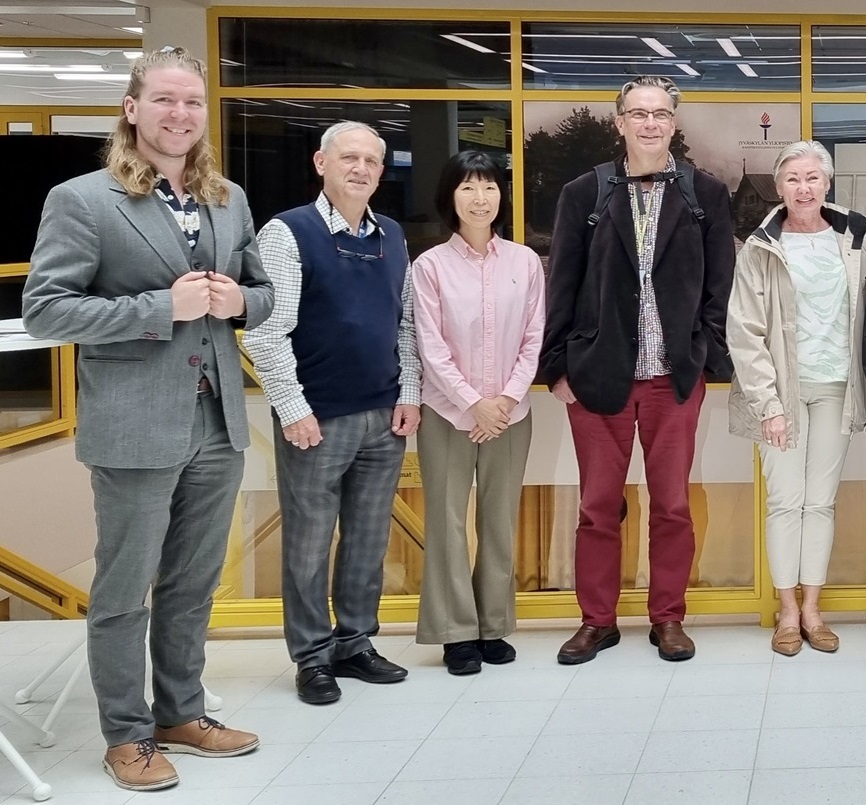
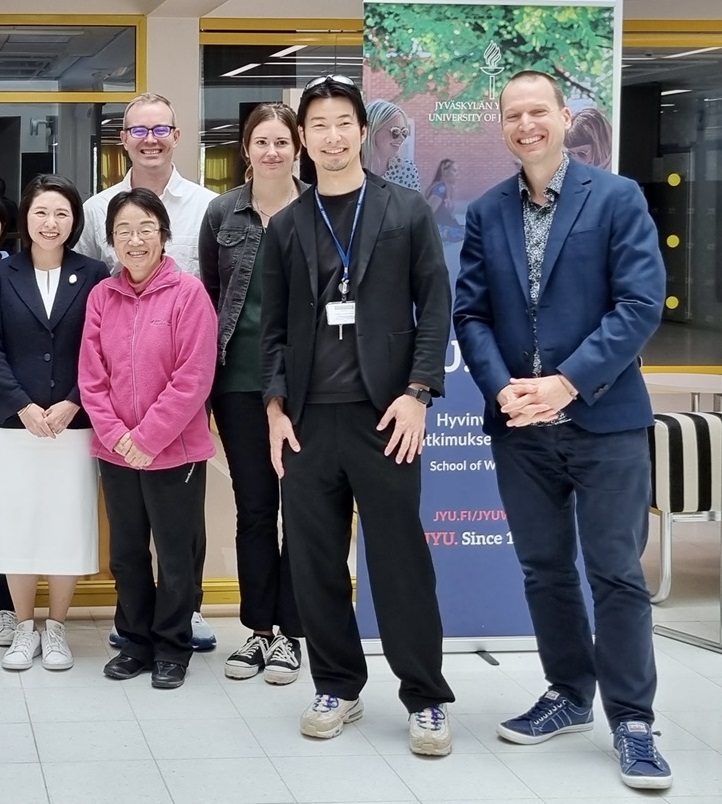
@University of Jyväskylä in 2023
連携(都道府県PJ:横山がメンバー):経済産業研究所 RIETI Project
<特定研究プログラム>労働市場における男女格差の原因と対策―人的資本、教育、企業人事、職業スキルの観点からの理論及び計量研究: Kazuo Yamaguchi, University of Chicago (山口一男 シカゴ大学ラルフ・ルイス記念特別社会学教授)代表
2017-2021の主な成果 / Main Results of Phase 1
JST Ristexに支援をいただきました。
--
--
パンフレット作製は東海大学教養学部芸術学科の富田誠先生に協力いただきました。
Assosiate Prof. Makoto Tomita at Tokai University designed the pamphlet.

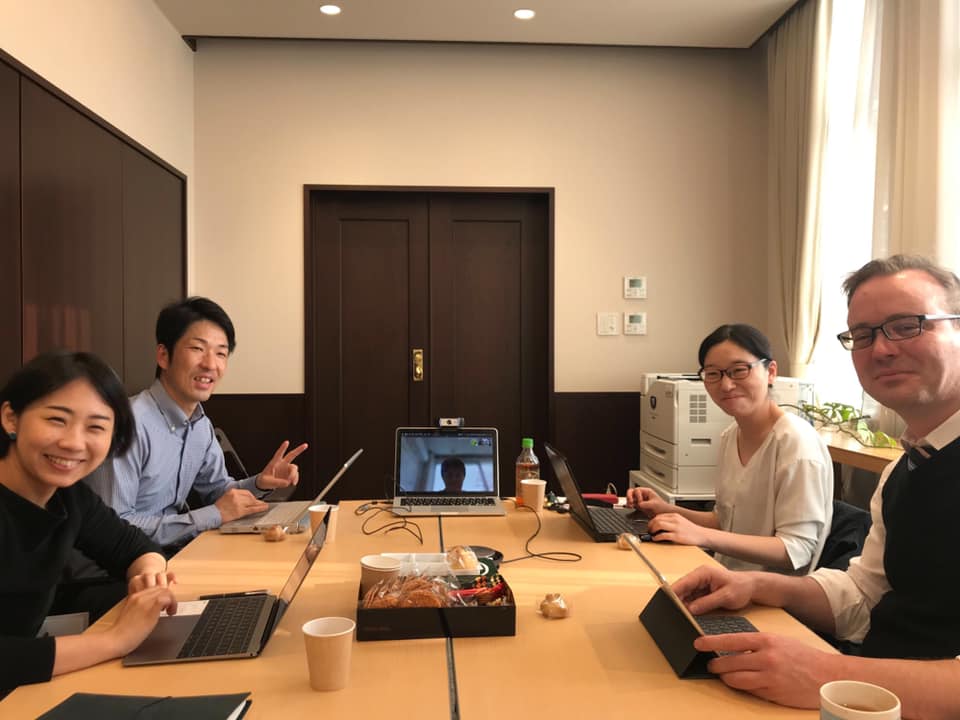
Group Photo in 2017 @ UTokyo, Hongo
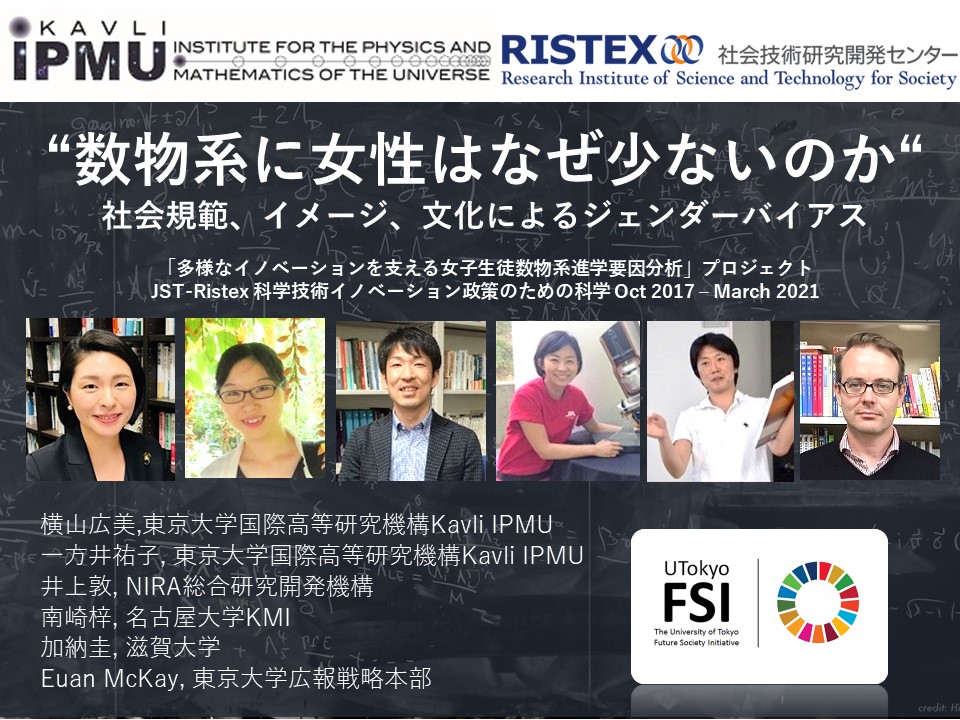
研究論文 / Research Papers
Hiromi M. Yokoyama, Yuko Ikkatai, Euan McKay, Atsushi Inoue, Azusa Minamizaki & Kei Kano (2024) Can affirmative action overcome STEM gender inequality in Japan? Expectations and concerns, Asia Pacific Business Review, DOI: 10.1080/13602381.2024.2320547
我々のチームのこれまでの論文の総括と女子枠についての議論:本グループが出版してきた10本の論文を総括して紹介。その上で、日本における理系女子枠の問題点を指摘した。
Summary of the our past papers and discussion on the women's quota:Compounding skill shortages from Japan’s shrinking and ageing workforce is low female participation in research and science-related areas. Why do so few women choose to work in science, technology, engineering and mathematics (STEM)? Previous research suggests the influence of gendered images of STEM fields, but do these apply to Japan, and if so, how? We introduce multiple studies that shed light on gendered images and elucidate the roles of those who affect women’s choices and women’s own attitudes. Our findings further suggest that a social climate of inequality affects the gendered images of STEM fields. Finally, we offer a critique of recent quota-based systems for increasing women’s STEM participation in Japan.
Ikkatai, Y., Inoue, A., Minamizaki, A., Kano, K., McKay, E. and Yokoyama, H. M.(2021) ‘Masculinity in the public image of physics and mathematics: a new model comparing Japan and England’. Public understanding of science,https://doi.org/10.1177/09636625211002375
モデル論文:日本に根強い数学や物理学の男性的イメージを説明する新モデルを提案し検証した。物理などの分野を大学で学ぶ女性が少ない要因を3つにまとめた先行研究を利用し、本研究ではさらに要因4 (性役割についての社会風土) を加えて男性的イメージを測定した点に新規性がある。新モデルに基づいて、インターネット調査を実施した結果、要因1の 「職業」、「数学ステレオタイプ」、「頭が良いイメージ」 が数学や物理学の男性的イメージに影響することに加え、要因4の要素のうち、「女性は知的であるほうがよい」ことに否定的な人ほど数学に対して男性的イメージを持つことがわかった。
Model paper: We proposed and tested a new model to explain the masculine image of mathematics and physics that persists in Japan. The novelty of this study is that it utilizes a previous study that summarized the three factors that cause few women to study physics and other fields at universities, and adds factor 4 (social climate regarding gender roles) to measure masculine image in this study. Based on the new model, we conducted an Internet survey and found that Factor 1, "occupation," "math stereotype," and "image of smart" affect the masculine image of mathematics and physics, and that among the factors of Factor 4, the more negative one is about "women should be intelligent," the more masculine one's image of mathematics is. In addition, among the factors of Factor 4, those who were negative about "women should be intelligent" were more likely to have a masculine image of mathematics.
Ikkatai, Y., Inoue, A., Minamizaki, A.,Kano, K., McKay, E. and Yokoyama, H. M.(2021).‘Effect of providing gender equality information on students’ motivations to choose STEM’.PLOS ONE.https://doi.org/10.1371/journal.pone.0252710
情報提供実験:モデル論文を元に、中学1年生の生徒に①理工系の就職ニーズに加えて、②平等社会、③女子は数学が得意と言う情報を読んでもらうと、理工系への進学意欲がますことがわかった。社会実装に活用するための研究である。就職情報は良く紹介されるが、これに加えて数学ステレオタイプを打ち消す情報と、平等情報は有効である。
Informational experiment: Based on a model article, we found that first-year junior high school students were more motivated to enter science and engineering when they read information about (1) the need for employment in science and engineering, as well as (2) an equal society and (3) that girls are good at mathematics. This research is intended to be used for social implementation. In addition to the employment information that is often presented, information that counteracts the mathematics stereotype and information on equality is effective.
Ikkatai, Y., Inoue, A., Kano, K., Minamizaki, A., McKay, E. and Yokoyama, H. M.(2021).‘Factors related to girls’ choice of physics for university entrance exams in Japan’.Physical Review Physics Education Research. (17), 010141 –
パイプライン論文:小中高を通じて、物理学会員は物理が好きだったが理系大卒では中学で物理が嫌いになる傾向があり、特に女性でその傾向が強いことがわかった。また、博物館や科学雑誌が好きだったり、小学校で物理や数学が好きだと高校での物理選択に影響があることが明らかになり、さらに物理学を研究する女性は数学ステレオタイプが低いことがわかった。
Pipeline Paper: We found that throughout elementary, middle, and high school, physics society members liked physics, but science college graduates tended to dislike physics in middle school, and this was especially true among women. It was also found that liking museums and science journals and liking physics and math in elementary school influenced physics choices in high school, and furthermore, women who studied physics were less likely to have math stereotypes.
Ikkatai Y.,Inoue A., Kano K., Minamizaki A., McKay E., & Yokoyama H.M.(2019). Parental egalitarian attitudes towards gender roles affect agreement on girls taking STEM fields at university in Japan’.International Journal of Science Education , 41(16), 2254-2270.,
親論文:多くの娘を持つ親が女性の理系進学に協力的であり、分野では薬学についで情報科学への賛同が多いことがわかった。情報科学は女性が極めて少ない分野であるが、就職が大変良いことを反映した結果であると見ている。また、男女平等意識の低い親は、女性の大学進学に否定的であることもわかった。
Parents' Paper: We found that many parents with daughters are supportive of women entering the sciences, and that in terms of fields, they are second only to pharmacy in their support for information science. Although information science is a field in which there are very few women, we see this result as reflecting the fact that employment is very good. The study also found that parents with low gender equality awareness were negative about women going to college.
Ikkatai, Y., Minamizaki, A., Kano, K., Inoue, A., McKay, E. and Yokoyama, H. M.(2020). ‘Gender-biased public perception of STEM fields, focusing on the influence of egalitarian attitudes toward gender roles’. JCOM 19 (01), A08. https://doi.org/10.22323/2.19010208.
一般イメージ論文:STEM を含む 18 分野に対するジェンダーイメージを調査した結果、分野に対する性別適正のイメージについて、女性は看護学、男性は機械工学に向いているというイメージが強く、性役割に対する平等主義的態度のレベルが低い回答者ほど、看護学が女性に向いている、STEM(科学・技術・工学・数学)に関する分野は男性に向いているという傾向が見られた。
General Image Paper: The results of the survey on gender images of 18 fields, including STEM, showed that in terms of gender appropriateness for the fields, women were more likely to image that women are suited to nursing and men to mechanical engineering, and respondents with lower levels of egalitarian attitudes toward gender roles were more likely to image that nursing is suited to women and fields related to STEM (science, technology, engineering, and mathematics) are suited to men.
Ikkatai, Y., Minamizaki, A., Kano, K., Inoue, A., McKay, E. and Yokoyama, H. M.(2020). ‘Masculine public image of six scientific fields in Japan: physics, chemistry,mechanical engineering, information science, mathematics, and biology’. JCOM 19 (06), A02. https://doi.org/10.22323/2.19060202.
キーワード論文:科学の 6 つの分野(物理学・化学・機械工学・情報科学・数学・生物)に対して日本人が持つ代表的なイメージを、キーワードで抽出しました。また、それぞれのキーワードのジェンダーイメージ(男性的あるいは女性的)を測定したところ、生物以外の分野でどのキーワードも男性度が高いことがわかった。
Keyword paper: We used keywords to identify the typical image Japanese people have of the six fields of science (physics, chemistry, mechanical engineering, information science, mathematics, and biology). The gender image (masculine or feminine) of each keyword was measured, and it was found that all keywords were highly masculine in all fields except biology.
井上敦(2019).親の数学のジェンダーステレオタイプと娘の自然科学専攻.日本科学教育学会第43回年会論文集,9-12. /Inoue, Atsushi (2019). Parents' Gender Stereotypes of Mathematics and Daughters' Natural Science Majors. Proceedings of the 43rd Annual Meeting of the Japanese Society for Science Education, 9-12.
母親数学スレテオタイプ論文:「女性は男性に比べて数学能力が低い」にそう思うと回答した母親の娘は、そう思わないと答えた母親の娘より理系進学の割合が低いことがわかりました。
Mothers Math Slepto-Type Paper: Daughters of mothers who responded that they agree with the statement "Women are less capable of mathematics than men" were less likely to go on to science school than daughters of mothers who responded that they do not agree.
井上敦・一方井祐子・南崎梓・加納圭・マッカイユアン・横山広美(2021).高校生のジェンダーステレオタイプと理系への進路希望, 科学技術社会論研究.(19) 64-78 / Inoue, Atsushi, Yuko Ikkatai, Azusa Minamizaki, Kei Kano, MacKay Euan, and Hiromi Yokoyama (2021). Gender stereotypes and career aspirations for science among high school students, Journal of Science, Technology and Society. (19) 64-78
高校生性役割分担意識論文:「男は外で働き、女は家庭を守るべきである」について、そう思わないと回答した女子のほうが、そう思うと回答した女子よりも理系進学が多いことがわかった。
High School Gender Role Attitudes Paper: Girls who disagreed with the statement "Men should work outside the home and women should take care of the home" were more likely to go on to science school than those who agreed with the statement.
一方井祐子・井上敦・南崎梓・加納圭・マッカイユアン・横山広美(2021).STEM分野に必要とされる能力のジェンダーイメージ:日本とイギリスの比較研究, 科学技術社会論研究.(19) 79 - 95 / Yuko Ikkatai, Atsushi Inoue, Azusa Minamizaki, Kei Kano, Mackay Euan, Hiromi Yokoyama (2021). gender images of abilities needed in STEM fields: a comparative study of Japan and the UK, Journal of Science, Technology and Society. (19) 79 - 95
能力論文:数学や物理学な必要な能力とは何かを論じ、それらを7つの能力に分類した。さらにそれらのジェンダー度を測定した結果、日本はそれぞれの能力が男性的であると回答する人がイギリスと比較して多いことがわかった。
Ability paper: We discussed what are the necessary abilities for mathematics and physics, and categorized them into seven abilities. Furthermore, we measured the gendered degree of each of these abilities, and found that more people in Japan responded that each of these abilities was masculine than in the UK.
南崎梓,一方井祐子,加納圭,井上敦,マッカイ・ユアン,横山広美 (2024), (報告) 高校物理選択における教師の無意識ジェンダーバイアスの探索的研究,JJSC,35,1-12
高校論文;日本の高校理科では,基礎科目を履修した後に履修する,応用的な理科科目の選択は生徒の自由意志に任せられることが多い.その結果,物理を選択する女子生徒の割合が著しく低く,女子生徒の多くは生物を選択している.この高校理科科目選択は大学学部の選択肢に直結し,日本における物理・工学系人材のキャリアパスの最初の分岐点である.この段階での大きなジェンダーアンバランスは科学コミュニケーションに関わる人々のダイバーシティとインクルージョンに強く結びつく課題である.物理工学系女性人材の極端な少なさは日本の特徴であるが,日本における高校理科科目選択のジェンダーバイアス研究は十分ではない.世界的にもPhysical science に男子学生が多くLife science に女子学生が多い傾向が見られるが,複合的な要因が指摘され単純ではないため,成長段階ごとに現れるジェンダーバイアスを一つずつ紐解くことが,問題理解に不可欠である.本研究では,日本の高校理科科目選択のバイアスの一つとして,高校教師に注目し,教師が生徒の性別に無意識に影響されるケースがあり得るかを探索的に調査した.ランダムに生徒情報を提供するオンライン実験の結果,教師は基本的には生徒の希望を応援するが,受験の選択肢が意識されるケースにおいて,女子より男子に物理を勧めることがわかった.社会風土や伝統的な性別役割分担意識が,物理選択推奨のジェンダーバイアスに影響を与えている可能性についても議論した.
In Japan, the percentage of female university students studying engineering and physics is extremely low. One reason is that in high school, female students tend to choose biology instead of advanced physics. This choice impacts future selection of university departments, marking a crucial point for physics and engineering careers in Japan. However, research on gender bias in Japanese high school science subject selection is still insufficient. Globally, more male students enroll in physical sciences, and female students in life sciences, but these phenomena have complex causes. Several elements have been pointed out, which are related to each other in complicated ways. To understand the issue, it's crucial to uncover gender biases at each stage of a student's growth. We conducted an exploratory study on high school teachers' unconscious gender bias. We explored whether teachers were unconsciously influenced by students' gender when advising on advanced science courses. The online experiment results revealed teachers generally supported students' preferences but encouraged boys to choose physics when teachers were aware of entrance exam options. The possibility that social climate and traditional gender role stereotypes may influence the gender bias of physical selection recommendations was also discussed.

